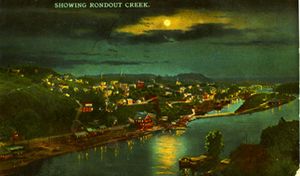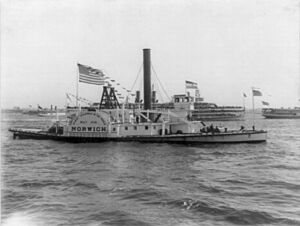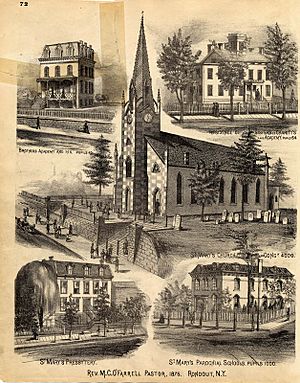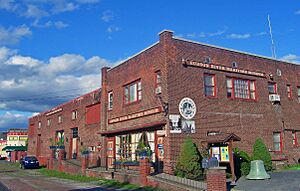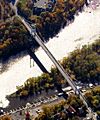Rondout, New York facts for kids
Rondout (pronounced "ron doubt") is a cool historic area in Ulster County, New York. It sits right on the Hudson River where the Rondout Creek flows into it. It started as a busy port town, especially after the Delaware and Hudson Canal opened. Rondout grew so much that it became the third largest port on the Hudson River! In 1872, it joined with nearby Kingston. Today, you can explore the Rondout–West Strand Historic District to see its history.
Contents
Rondout's Fascinating History
Rondout is located at the mouth of Rondout Creek, which connects to the Hudson River. The Dutch people first settled here in the 1600s. They set up a trading post to trade with Native Americans. Furs from inland areas were brought down the Rondout, Wallkill River, and Esopus Creek. Then, they were shipped by boat down the Hudson River to New York City.
The name "Rondout" comes from a fort, or "redoubt," that was built near the creek's mouth. In Dutch, a fort was called a "reduyt." Early records used the spelling "Ronduyt," and by 1666, the spelling "Rondout" appeared.
The Delaware & Hudson Canal's Impact
In the 1820s, Rondout was just a small village. But then, two brothers, William and Maurice Wurts, had a big idea. They wanted to bring coal from their mines in Carbondale, Pennsylvania, to New York City. So, they built the Delaware and Hudson Canal. This canal opened in 1828.
After the canal opened, Rondout quickly changed from farmland into a busy port village. The canal connected coal mines in Pennsylvania to the Hudson River. Many Irish workers came to dig the canal, and many stayed to work on it. New businesses opened to serve these workers.
Boats of all kinds – steamboats, sloops, schooners, and barges – regularly left Rondout for New York City. New industries also started, like making bricks and cement, shipping bluestone, and even making ice. As more canal boats arrived, homes and shops were built up the hill from Rondout Creek.
By 1840, Rondout had about 1,500 people. It had 200 homes, two churches, six hotels, 25 stores, and many businesses related to shipping and boat building.
Steamboats, Cement, and Growth
Rondout Creek was home to the Cornell Steamboat Company. This company had a huge fleet of tugboats, which were the main way to tow barges on the Hudson River from the 1880s to the 1930s. The company started in 1847. At one point, they had 62 tugboats! These tugboats pulled barges filled with coal and other materials to New York and other ports. Cornell Steamboat Company employed hundreds of people.
By 1872, over 30 steamboats were based in Rondout. Many of them carried stone, coal, cement, bricks, and ice. Famous steamboats like the Mary Powell regularly traveled between Rondout and other places on the river.
One special steamboat was the Norwich. Built in 1836, she was known as "the Ice King." She was excellent at breaking ice, helping to open up the river channels in the spring. The Norwich worked on the Hudson River until 1917, making her one of the longest-working steamboats.
Before it became an official village, Rondout was called "The Strand," "Kingston Landing," or "Bolton." "The Strand" referred to a beach on the north side of Rondout Creek. "Bolton" honored a president of the Delaware and Hudson Canal Company. Rondout officially became a village on April 4, 1849.
Many businesses thrived in Rondout. In 1851, Israel Sampson built the Sampson Opera House. He ran a clothing store on the first floor, and the top floor was the Opera House. Later, a newspaper, The Daily Freeman, used the building. The Mansion House Hotel was built in 1854, offering a place for steamboat and stagecoach passengers to stay.
One of the most important businesses was The Newark Lime and Cement Manufacturing Company, which started in 1851. They owned 250 acres and made cement from stone quarried right behind the factory. They could produce over 1,000 barrels of cement a day! This company employed 250 to 300 men.
A steam ferry connected Rondout to the Hudson River Railroad across the river in Rhinecliff. A trolley also connected Rondout to Kingston. Rondout had ten churches, three banks, two newspaper offices, and three public schools. It had about 10,000 people when it merged with Kingston in 1872.
The Great Blizzard of 1888
The Blizzard of 1888 was one of the worst storms to hit the eastern coast. It started on Sunday, March 11, 1888, and lasted until Monday night. Even though there were only two or three feet of snow, strong winds up to 60 miles per hour created snowdrifts 10 to 20 feet high!
During the storm, a rare "blowout tide" happened. This is when strong winds push water away, making the creek very shallow. Boats in Rondout Creek were left stuck on the bottom, including the ferry boat and the Norwich. Travel was very difficult, and many people were stranded.
By the early 1900s, shipping coal by train became cheaper than by canal. Also, a new type of cement called Portland cement replaced bluestone in building. As less material was shipped, the port of Rondout became less busy.
The Kingston-Port Ewen Suspension Bridge was finished in 1921. It crosses Rondout Creek, connecting Rondout to Port Ewen, New York. Before this bridge, people crossed the creek using a chain ferry called the "Skillypot."
Rondout's economy briefly improved during World War II when three shipyards built naval vessels. Later, when a new bridge was built, some old buildings were torn down. This led people to protect the remaining historic area, which became the Rondout-West Strand Historic District.
Rondout's Religious Communities
St. Mary's Catholic Church
As early as 1835, Catholic workers who came to Rondout for the D&H Canal wanted to build a church. Many were Irish immigrants. A small wooden church was built in 1840. In 1848, they started building a new brick church, which was finished in 1849.
St. Mary's helped establish other churches in nearby towns. It also opened St. Mary's Academy, a school run by the Sisters of Charity. In 1867, Father James Coyle built a large school building, which is now Kingston Catholic School.
In 2013, St. Mary's restored its beautiful stained-glass windows. A Celtic cross in the courtyard remembers the Great Famine of Ireland and the many Irish people who came to the U.S.
Holy Name of Jesus
The hamlet of Wilbur, downstream from Eddyville, was a busy place for bluestone. In 1884, a brick church was built there, with people from Wilbur donating their time and effort. The Holy Name of Jesus church was dedicated in 1885 and became its own parish in 1887. This parish later joined with St. Mary's in Rondout.
St. Peter's Catholic Church
German immigrants also came to Rondout to work on the D&H Canal. St. Peter's parish was started by German Catholics. A new, larger church was built on Wurts Street and dedicated in 1872. St. Peter's Cemetery opened in 1860.
St. Peter's also had a school, which opened in 1858. In 1970, St. Peter's school combined with St. Mary's to form Kingston Catholic School. For many years, sermons were preached in German. In 2002, St. Peter's started a Hispanic ministry to serve the changing community. In 2015, St. Peter's parish merged with St. Mary/Holy Name.
Immaculate Conception Catholic Church
The first Polish people settled in Kingston in 1875 and attended St. Peter's. The Church of the Immaculate Conception was started in 1893 to serve the growing Polish community. The church on Delaware Avenue was built in 1896, with parish members helping the bricklayers. It was dedicated in 1897.
The parish school was built in 1907 and run by the Felician Sisters. The church bells were blessed in 1920. During World War II, the parish prayed for the safety of its members serving in the armed forces. After the war, a monument was built next to the church to honor those who served.
Fun Events in Rondout
The City of Kingston hosts many fun festivals in the Rondout area.
- Artists' Soapbox Derby: This annual event, started in 1995, combines soapbox racers with works of art! You can watch these creative "sculptures" race down Broadway to the Strand. Prizes are given for different categories, like "Most Awkward."
- Hooley on the Hudson: This is a traditional Irish celebration held every Labor Day weekend. It includes a parade that ends at T.R. Gallo Memorial Park. The Hooley festival has music, food, craft vendors, and step dancers. It's a great way to celebrate after the summer harvest!
Cool Places to Visit
The Rondout Visitor Center is located at 20 Broadway, right on the Rondout Waterfront. Rondout is also home to several art galleries and museums:
- The Trolley Museum of New York
- The Kingston Museum of Contemporary Arts
- The Arts Society of Kingston
- Deep Listening Space
Rondout-West Strand Historic District
The Rondout-West Strand Historic District is a big part of the old 1800s village of Rondout. It was added to the National Register of Historic Places in 1979. Because business slowed down after 1900, many of the buildings from the 1800s are still standing. Even though some parts of Rondout were torn down, this area still shows what a busy trading and industrial community it once was. The streets still look much like they did in the mid-to-late 1800s.
The Hudson River Maritime Museum was founded in 1980. People who loved steamboats and tugboats, and local citizens, wanted to save the history of shipping on the Hudson River. Kingston was also an important stop for passenger steamboats bringing tourists to the area. The museum is located at 50 Rondout Landing, at the foot of Broadway. The Clearwater often docks here, as do other historic replica ships.
The Irish Cultural Center Hudson Valley is working to turn the old D&H Canal Corp headquarters into an Irish Cultural Center. This site is important to Irish history in the Hudson Valley because the area was once called "Little Dublin" due to the many Irish laborers who built the canal and stayed to work there.
Images for kids
-
The Wurts Street Bridge (also known as the Kingston-Port Ewen Suspension Bridge)
-
Kingston Point, part of the former town of Rondout, and the trolley
-
A steeple restored in 2006 on Wurts Street in Rondout


